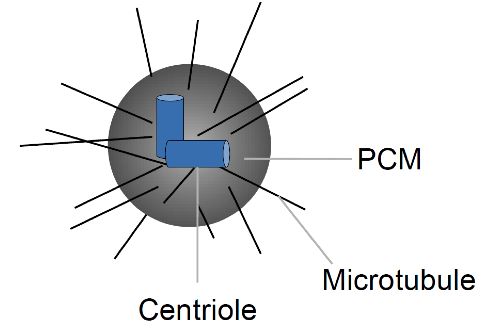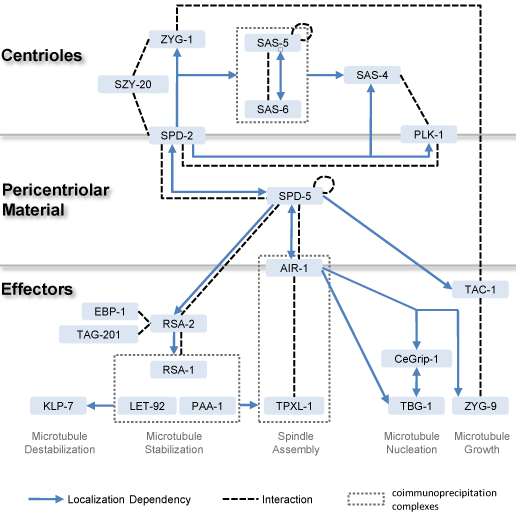The Centrosome
 The centrosome is a non-membrane bound, dynamic organelle that acts as a microtubule organizing center and is involved in the assembly and positioning of the mitotic spindle. It is composed of two domains - a pair of orthogonally arranged centrioles [1] [ibioseminars] at the center that are surrounded by a mass of pericentriolar material (PCM) from which microtubules nucleate. Research over the last years has revealed a rough assembly pathway of the centrosome [2], but its precise structure and physical properties remain mysterious.
The centrosome is a non-membrane bound, dynamic organelle that acts as a microtubule organizing center and is involved in the assembly and positioning of the mitotic spindle. It is composed of two domains - a pair of orthogonally arranged centrioles [1] [ibioseminars] at the center that are surrounded by a mass of pericentriolar material (PCM) from which microtubules nucleate. Research over the last years has revealed a rough assembly pathway of the centrosome [2], but its precise structure and physical properties remain mysterious.
The centrioles recruit a small initial pool of PCM. Upon entry into mitosis, the PCM dramatically increases in size by the recruitment of additional components, a process termed maturation [3]. We have recently shown that the length of the mitotic spindle is set in part by the size of the PCM [4]. In this project, we aim to understand the mechanism that controls the size of the PCM.

[1] L. Pelletier, E. O’Toole, A. Schwager, A. A. Hyman, and T. Müller-Reichert, “Centriole assembly in Caenorhabditis elegans”, Nature, vol. 444, pp. 619-623, 2006 [Download]
[2] M. Boxem, Z. Maliga, N. Klitgord, N. Li, I. Lemmens, M. Mana, L. de Lichtervelde, J. Mul, D. van de Peut, M. Devos, et al., “A protein domain-based interactome network for C. elegans early embryogenesis,” Cell, vol. 134, no. 3, pp. 534–545, 2008. [Download]
[3] R. Palazzo, J. Vogel, B. Schnackenberg, D. Hull, and X.Wu, “Centrosome maturation,” Current Topics in Developmental Biology, vol. 49, pp. 449–470, 1999. [Download]
[4] G. Greenan, C. P. Brangwynne, S. Jaensch, J. Gharakhani, F. Jülicher, and A. A. Hyman, “Centrosome Size Sets Mitotic Spindle Length in Caenorhabditis elegans Embryos”, Current Biology, vol. 20, pp. 353–358, 2010 [Download]